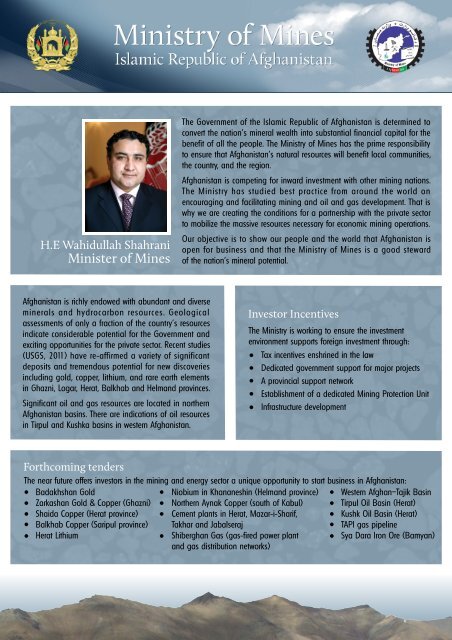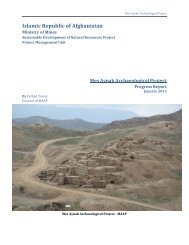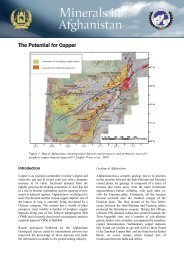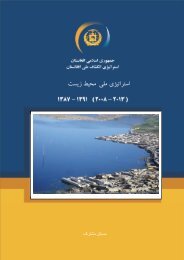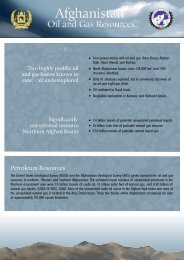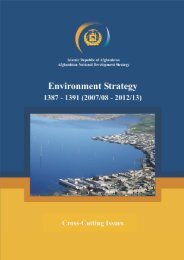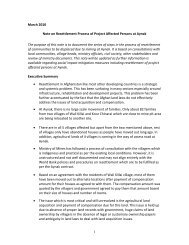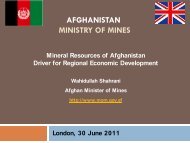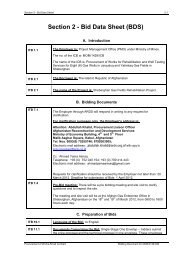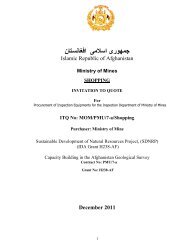Create successful ePaper yourself
Turn your PDF publications into a flip-book with our unique Google optimized e-Paper software.
H.E Wahidullah ShahraniMinister <strong>of</strong> <strong>Mines</strong>The Government <strong>of</strong> the Islamic Republic <strong>of</strong> Afghanistan is determined toconvert the nation's mineral wealth into substantial financial capital for thebenefit <strong>of</strong> all the people. The <strong>Ministry</strong> <strong>of</strong> <strong>Mines</strong> has the prime responsibilityto ensure that Afghanistan's natural resources will benefit local communities,the country, and the region.Afghanistan is competing for inward investment with other mining nations.The <strong>Ministry</strong> has studied best practice from around the world onencouraging and facilitating mining and oil and gas development. That iswhy we are creating the conditions for a partnership with the private sectorto mobilize the massive resources necessary for economic mining operations.Our objective is to show our people and the world that Afghanistan isopen for business and that the <strong>Ministry</strong> <strong>of</strong> <strong>Mines</strong> is a good steward<strong>of</strong> the nation's mineral potential.Afghanistan is richly endowed with abundant and diverseminerals and hydrocarbon resources. Geologicalassessments <strong>of</strong> only a fraction <strong>of</strong> the country's resourcesindicate considerable potential for the Government andexciting opportunities for the private sector. Recent studies(USGS, 2011) have re-affirmed a variety <strong>of</strong> significantdeposits and tremendous potential for new discoveriesincluding gold, copper, lithium, and rare earth elementsin Ghazni, Logar, Herat, Balkhab and Helmand provinces.Significant oil and gas resources are located in northernAfghanistan basins. There are indications <strong>of</strong> oil resourcesin Tirpul and Kushka basins in western Afghanistan.Investor IncentivesThe <strong>Ministry</strong> is working to ensure the investmentenvironment supports foreign investment through:Tax incentives enshrined in the lawDedicated government support for major projectsA provincial support networkEstablishment <strong>of</strong> a dedicated Mining Protection UnitInfrastructure developmentForthcoming tendersThe near future <strong>of</strong>fers investors in the mining and energy sector a unique opportunity to start business in Afghanistan:Badakhshan GoldZarkashan Gold & Copper (Ghazni)Shaida Copper (Herat province)Balkhab Copper (Saripul province)Herat LithiumNiobium in Khananeshin (Helmand province)Northern Aynak Copper (south <strong>of</strong> Kabul)Cement plants in Herat, Mazar-i-Sharif,Takhar and JabalserajShiberghan Gas (gas-fired power plantand gas distribution networks)Western Afghan–Tajik BasinTirpul Oil Basin (Herat)Kushk Oil Basin (Herat)TAPI gas pipelineSya Dara Iron Ore (Bamyan)
<strong>Minerals</strong>Aynak copper depositAynak copper deposit has proven reserve <strong>of</strong> 240mt @ 2.3% Cu;excellent potential for similar strata-bound Cu deposits with Kabuland Logar Provinces. Excellent potential for porphyry copper-goldalso exist along the strike-extensions <strong>of</strong> the highly prolific TethyanEurasian Mineral Belt, (TEMB).Hajigak iron ore deposit has 1,800mt @ 63% Fe indicated resource.Excellent potential for similar iron deposits exist within the Neo-Proterozoicmetamorphic belt as exemplified by the discovery <strong>of</strong> Syadara irondeposit, located 110km to the west.Industrial <strong>Minerals</strong>: Celestine, chromite, clays, fluorite, graphite, gypsum,halite, magnesite, and talc deposits are found across the country. A smallnumber <strong>of</strong> deposits are being exploited through the artisanal and smallscale mining methods. There is great potential for medium and largescale exploitation <strong>of</strong> some <strong>of</strong> these deposits.Geological work has also identified significant gold, silver, manganese,lead, rare earth metals, rhenium, tin, tungsten, zinc and bauxite deposits.Rare MetalsTectonic Map <strong>of</strong> Afghanistan showinglocation <strong>of</strong> Rare Metal depositsIn Afghanistan, rare metals (lithium, caesium, cobalt, tantalum andniobium) occur in three main deposit types. The most potentiallysignificant and easily extractable resources <strong>of</strong> rare metals occur inmineralised springs and playas although there is also considerablepotential for exploiting hard-rock pegmatite deposits.Pegmatites have been known in eastern Afghanistan since ancient timesand are still exploited for precious stones and rare metals, such askunzite and aquamarine using smallscale surface and undergroundexcavations.There are three maintypes <strong>of</strong> mineralised springs in Afghanistan:carbonated springs, nitrous and sulphurous springs and water springs.Only the carbonated springs are associated with high-rare metalconcentrations. No systematic modern exploration or assessments <strong>of</strong>pegmatites has been carried out since the withdrawal <strong>of</strong> the Soviet forcesand many <strong>of</strong> the known localities warrant further investigation andexploration based on modern mineral deposit models and techniques.Energy ResourcesAfghanistan's discovered natural gas reserves reside in eight fields in the north and northwest <strong>of</strong> the country. Onthe basis <strong>of</strong> available data the combined remaining reserves <strong>of</strong> “proven” natural gas is approximately 15.6 trillioncubic feet (TCF) with some experts suggesting potential reserves <strong>of</strong> more than 30 TCF.Six oil fields have been discovered in northern Afghanistan within Amu-Darya, Afghan-Tajik and Kushka basins.Remaining Soviet reserves estimates are 87 MMBO but recent USGS-AGS estimated potential <strong>of</strong> up to 1.66 billionBO. Discovered oil reserves are located in the Sari-Pul province although undeveloped reserves in the north and anindication <strong>of</strong> oil in the south have not been explored.The coal is primarily located within a Jurassic belt from the northern provinces <strong>of</strong> Takhar and Badakhshan throughthe center <strong>of</strong> the country (Baghlan, Samangan) and towards the west in Herat.The Afghan Hydrocarbon Sector is managed by the <strong>Ministry</strong> <strong>of</strong> <strong>Mines</strong> with two primary State Owned Enterprises(SOEs) and some small private sector operations.
Upcoming TendersThe <strong>Ministry</strong> <strong>of</strong> <strong>Mines</strong> has recently set an ambitious and exciting tendering plan for some <strong>of</strong> our most promisingresources. Five highly prospective mineral properties in Afghanistan briefly described below will be tendered inseparate blocks for exploration and development.Balkhab―VMS CuThe Balkhab Cu prospect is located approximately 300kmNW <strong>of</strong> Kabul. USGS have defined a block <strong>of</strong> silicifiedlimonitic rocks measuring 4-5 Km long by 0.40 Km wide(depth unknown). Malachite, azurite, pyrite anddisseminated chalcopyrite, bornite and galenamineralization are associated with felsic volcanic rocks.This prospect holds oxide + sulphideCu potential and drillreadydepending on the outstanding assay results fromrecent AGS work. Interpretation <strong>of</strong> Aster images revealed 21significant anomalies with signatures consistent withVMS bodies.Shaida 1―Cu/Pb/Zn VMS andPossible PorphyryThe Shaida prospect is located 65 km south-southwest <strong>of</strong>Herat, (Provincial capital) and approximately 27km east <strong>of</strong>Highway A01 (Ring Road).This block contains Shaida and Shaida1 VMS prospectsand several unnamed anomalies. Porphyry was notspecifically identified by the Soviets, but characteristicsconsistent with this deposit type and well-developedgossans were documented. Moderate amount <strong>of</strong> historicwork were conducted including mining, drilling, trenchingand shafts.Badakhshan―Shear Zone Hosted AuThis property contains Veka Dur gold vein prospect inthe Ragh area and other vein Au-Ag prospects. Gold isassociated with structurally-controlled quartz-sulphideveins hosted in metamorphic rocks.Moderate amount <strong>of</strong> historic work comprising trenching,underground sampling, pits and adits were completed.Veka Dur prospect is the most studied deposit: quartzveins are up to 350 m in strike extent, with variablewidths (average <strong>of</strong> 2.0 m) while depth extensions werenot tested. 1,283 trench samples from Veka Dur prospectwere analyzed, <strong>of</strong> which 18% (230) >1.0g/t Au, and 4%(52) >5.0g/t Au. Historic Russian “reserves” (C1 and C2 )was 958 kg Au @ 4.1 g/t.Namaskar-e-Herat ― Li SalarCurrently at a very early prospect stage; Namaksar-e-Herat is most prospective <strong>of</strong> the eight identified salars.Li, B, K potential within Afghanistan is prospective andfurther verification drilling, brine sampling and analysisare planned. Geologic characteristics <strong>of</strong> the salar atNamaksar-e-Herat are consistent with known lithiumbrine deposits. This property <strong>of</strong>fers exciting explorationand development targets for lithium.Zarkashan―Cu/Au SkarnThe Zarkashan block is located approximately 225 kmsouth-southwest <strong>of</strong> Kabul within the extension <strong>of</strong> thehighly prolific “Tethyan Mineral Belt”. The Zarkashanblock contains several Cu/Au skarn prospects includingZ a r kas h a n , D y n a m i t i c , Z a r d a k a n d o t h e r s .Moderate amount <strong>of</strong> historic exploration work completedin the area. Russian resource estimates at Zarkashanprospect are 525 kgs Au at 7.1 g/t Au(C2) and 2,192kgs at 6.9 g/t Au (P category). Soviet inferred < 300kgAu resource for Zardak gold prospect. Work atZarkashan prospect indicates a strike length <strong>of</strong> over 1km with widths up to 57m. Gold in the trench samples isup to
There is a wide variety <strong>of</strong> marble in Afghanistan currently extractedfrom quarries in Badakhshan, Balkh, Bamyan, Helmand, Herat, Kabul,Kandahar, Logar, Faryab, Wardak, Nangahar, Paktia, Parwan andSamangan provinces.Marbles developed in rocks <strong>of</strong> Proterozoic age are considered to bethe highest quality for use as dimension stone.Quarrying <strong>of</strong> this material <strong>of</strong>ten involves very basic techniques, andmarble is <strong>of</strong>ten exported as unprocessed blocks or unpolished slabs.Other quarries produce and export granite, limestone and sandstone.Quarrying licenses, along with licenses to extract construction materialcomprise more than 90% <strong>of</strong> the approximately 600 mining licencescurrently issued in Afghanistan.Exotic Granite <strong>of</strong> the highest quality has recently been discovered bythe Afghan Geological Survey in Samangan province.MarbleMarble processing factory in AfghanistanGemstonesSample <strong>of</strong> Afghan GemstoneAfghanistan remains rich in precious and semi-precious gemstonedeposits. Precious gems including emeralds, rubies and sapphiresare mined here and semi-precious lapis lazuli, tourmaline,aquamarine, kunzite, topaz, garnets, fluorite and varieties <strong>of</strong>quartz have also been extracted.Gemstone mining in Afghanistan is typically an artisanal activity,carried out by people living in villages surrounding the mines.Recent government initiatives are addressing the economic issuesassociated with gemstone production. A new Mining Law hasbeen passed and regulations are being developed to provide theframework for more formal exploration and mining. TheGovernment <strong>of</strong> Afghanistan is starting to formalize the industry byasserting its control in rural areas.Gold has been worked in Afghanistan for centuries from many areasincluding Badakhshan and Takhar province in the north, and Ghazni,Zabul and Kandahar provinces in the south-west <strong>of</strong> the country.Gold deposits and prospects are known in rocks <strong>of</strong> Proterozoic toNeogene age. Many styles <strong>of</strong> gold mineralization occur, in particularskarn, vein-hosted, porphyry related and alluvial.Afghanistan is relatively under-explored and has not yet beenevaluated in the light <strong>of</strong> modern mineral deposit models and using upto-datesophisticated analytical methods and exploration techniques.There is significant potential for further discoveries <strong>of</strong> goldmineralization throughout the country in a variety <strong>of</strong> styles especiallyporphyry copper-gold, skarn copper-gold and oxidized intrusiverelated mineralization.GoldOpening ceremony for the Noorabaand Samti Gold ProjectContact DetailsInvestment Promotion Directorate<strong>Ministry</strong> <strong>of</strong> <strong>Mines</strong>Kabul, AfghanistanTelephone: +93 (0) 752 076 483E-mail: miningenquiries@mom.gov.afWebsite: http://www.mom.gov.af


